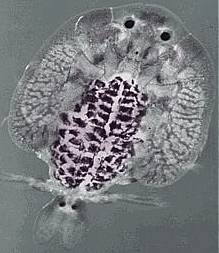DUNCAN GRIFFITHS
2002
Argulus belongs to the copepods genus, but is sub-classed (Branchiura),
this sub-class consists
of around 150 species of which approximately a hundred of these are of the
Argulus family. As with Lernaea its good news,bad news for the exact same
reasons, easy to spot hard to deal with, yet
again, Argulus has a fascinating life cycle.
The fish lice Argulus can be seen with the naked eye and dependant on the
species it can grow up
to a whopping 1cm, like Lernaea has an exoskeleton made up of Chitin (pronounced
"Ki tn")
Transmission is by introduction of infected water, fish or amphibians, such
as frogs and toads and
in rare cases it can be transported on the feet and feathers of birds (a kind
of air born transmission).
Argulus is a true parasite feeding on nutrients obtained from the tissue of
the host by means of a needle like projection called a Stylet. Both male and
female are oval in shape, being both broad and
flat, the head and thorax are in fact separate although they appear to be
as one, (Cephalothorax). Argulus is convex dorsally (top) and concave ventrally
(bottom). The underside housing suckers, barbs and mandibles for holding on
to the host which causes great damage. Two eyes are located in the head and
lying between the eyes and the mandibles is the stylet surrounded by a sheath.
Argulus will thrust the stylet into the host's flesh to begin feeding.
There are four pairs of swimming legs that make Argulus very adept at swimming
and manoeuvring
on the host. Argulus must live on the host and almost any region is acceptable,
with caudal fins
being a particular favourite. When the female is ready to lay her eggs she
will drop off the host and swim to the pond bottom and lay in the substrate
or a plant, there she will attach her eggs in a mucus coating to protectthem
and secure them to her chosen site.
Argulus, nauplii & metanauplii stages develop within the egg up to the
first copepod stage, which
will limit treatments some what as the eggs are protected by a some what impenetrable
shell.
The second stage copepod has one pair of swimming legs and is approx 1mm in
length, metamorphism continues totake place until the copepod reaches the
seventh stage (sub adult) to
get from sub adult to full adult takes approx 2 weeks, dependant on species,
water temperature and involves further numerous moults, the whole life cycle
will complete in approx 100 days, dependent
on conditions and species.
Argulus, when feeding will release a haemorrhaging chemical into the host,
which prevents clotting
of the blood and keeps the bodily fluids, blood, etc flowing, at the same
time Argulus also releases a chemical messenger that attracts other fish lice
to feed at the same site and further damage occurs.
Heavy infestations, as opposed to just the odd one or two, of both Argulus
and Lernaea are quite common when infection occurs, and is a major cause of
secondary bacterial infections leaving
serious wounds and the fish very lethargic. The wounds from Argulus heal quite
slowly, if at all
without outside intervention and will show signs of haemorrhaging.
Treatment.
Masoten @ 1 gm per 87 gallons over 65deg weekly for four treatments, or below
65 deg, 6/8 gm per 1000 imperial gallons is the treatment that I choose.
Salt is not an option as most life stages of Argulus can resist up to 3.5%
salinity.
Dimilin may be an option for Argulus if Masoten is not available.
Argulus can't stand being dried out so drying the pond and equipment is an
option after first
removing the fish for treatment to a q-tank.
